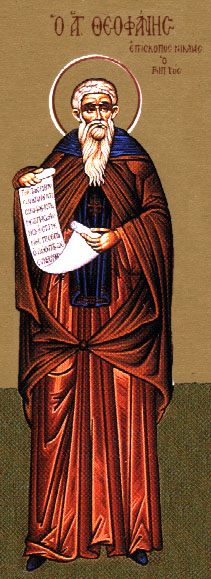Theophanes the Confessor facts for kids
Quick facts for kids SaintTheophanes the Confessor |
|
|---|---|
 |
|
| Confessor | |
| Born | c. 758–760 Constantinople, Byzantine Empire |
| Died | 12 March 817 (aged 57–59) Samothrace, Thrace, Byzantine Empire |
| Venerated in | Roman Catholic Church; Eastern Orthodox Church |
| Feast | 12 March (Catholic Church); 12 March (Julian Calendar for Orthodox Church) |
Theophanes the Confessor was a very important person in the Byzantine Empire. He was born around 758 and died in 817. He started his life as a noble and worked for the emperor. Later, he became a monk and a writer. He is famous for writing a big history book called a "Chronicle."
Theophanes was also known for defending icons, which were religious images. Because of this, he was put in prison. He is now considered a saint in both the Eastern Orthodox Church and the Roman Catholic Church. His special day is March 12th.
Contents
The Early Life of Saint Theophanes
Theophanes was born in Constantinople, a big city in the Byzantine Empire. His parents were wealthy and noble. They believed in honoring icons, which were religious pictures. His father, Isaac, was a governor of islands in the Aegean Sea.
When Theophanes was only three years old, his father passed away. The Byzantine Emperor, Constantine V, then helped with Theophanes' education. He grew up at the imperial court. Later, Theophanes held several important jobs for Emperor Leo IV the Khazar.
Becoming a Monk
At the age of eighteen, Theophanes got married. However, he and his wife decided to live a life dedicated to God. They chose not to have children. In 779, after his father-in-law died, they both agreed to become monks and nuns.
His wife went to a convent on an island near Constantinople. Theophanes joined the Polychronius Monastery. This monastery was located near a city called Cyzicus. Later, he built his own monastery on an island called Calonymus. There, he became very skilled at copying old books by hand.
After six years, he returned to Sigriano. He started a new monastery there and became its leader, known as an abbot. In 787, he attended an important meeting called the Second Council of Nicaea. At this meeting, he strongly supported the use and respect of icons.
Standing Up for Icons
Later, a new emperor, Leo V the Armenian, started a period called Iconoclasm. This meant he wanted to destroy icons and stop people from honoring them. Emperor Leo V ordered Theophanes to come to Constantinople.
The emperor tried to make Theophanes agree to stop honoring icons. But Theophanes refused. Because of his strong beliefs, he was thrown into prison. He suffered there for two years.
After his release, he was sent away to an island called Samothrace in 817. He was very sick and weak from his time in prison. He died just seventeen days after arriving there. Many people believed that miracles happened after his death. He is remembered on March 12th.
Theophanes' Famous Book: The Chronicle
Theophanes is most famous for writing a large history book called a "Chronicle." He started writing it between 810 and 815. He did this because his friend, George Syncellus, asked him to continue his own history book.
The language in Theophanes' book is a mix of formal church language and everyday Greek. He used several sources to write his history. He used notes from Syncellus, and also information from other historians.
Theophanes' part of the Chronicle covers events from the year 284 to 813. This book is very important because it saved stories from earlier times. Without it, we would have lost a lot of information about Byzantine history.
The Chronicle has two main parts. The first part tells history year by year. The second part has tables of dates. Sometimes, the dates in the tables can be a bit confusing. Theophanes also used a complex system to keep track of years. He included the years of emperors, kings, and religious leaders.
Even with some small errors, Theophanes' Chronicle is much better than many other history books from his time. It is especially valuable for the period starting from the year 565. This is because he used sources that no longer exist today.
Many later historians used Theophanes' Chronicle to write their own books. In the 870s, a librarian named Anastasius Bibliothecarius made a Latin version of the Chronicle. This helped people in Western Europe learn about Byzantine history. There was also a continuation of his Chronicle written by other writers, which covered history up to the year 961.


